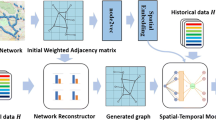Abstract
Traffic flow generation problem under realistic scenarios has raised more and more attention in recent years. This problem aims at generating traffic flow without using historical traffic data. Since road network and Point of Interest (POI) data can provide a more comprehensive picture of traffic patterns, most previous methods use both or either of them to generate traffic flow. However, roadnet graph in real-world has bias and abnormal structure, which will influence the performance of traffic generation. Previous traffic generation models directly receive real-world roadnet graph with map-match POI data as input and then use an end-to-end loss for training, which could not model the complex relationship between POI and traffic in a proper way. Different from prior methods, we propose a novel POI-based \(\underline{{\textbf {T}}}\)raffic \(\underline{{\textbf {G}}}\)eneration model via \(\underline{{\textbf {S}}}\)upervised \(\underline{{\textbf {C}}}\)ontrastive learning on \(\underline{{\textbf {R}}}\)econstructed graph, termed as TG-SCR, which combines POI data and road network data to generate the distribution of traffic flows. Our model has two novel modules: a graph reconstruction module and a POI supervised contrastive module. The graph reconstruction module includes a k-NN graph builder and a k-NN graph aggregator, which is used to reconstruct the original roadnet graph into a k-NN graph and reform POI feature. The contrastive module is used to model the relationship between POI feature and traffic flow. Extensive experiments show that our model outperforms other baseline methods on four real-world datasets.
Access this chapter
Tax calculation will be finalised at checkout
Purchases are for personal use only
Similar content being viewed by others
References
Bai, L., Yao, L., Li, C., Wang, X., Wang, C.: Adaptive graph convolutional recurrent network for traffic forecasting. Adv. Neural. Inf. Process. Syst. 33, 17804–17815 (2020)
Breiman, L.: Random forests. Mach. Learn. 45, 5–32 (2001)
Chen, T., Guestrin, C.: XGBoost: a scalable tree boosting system. In: Proceedings of the 22nd ACM SIGKDD International Conference on Knowledge Discovery and Data Mining, pp. 785–794 (2016)
Cortes, C., Vapnik, V.: Mach. Learn. Support-vector networks 20, 273–297 (1995)
Hamilton, W., Ying, Z., Leskovec, J.: Inductive representation learning on large graphs. Adv. Neural Inf. Process. Syst. 30 (2017)
Jiang, R., et al.: DeepCrowd: a deep model for large-scale citywide crowd density and flow prediction. IEEE Trans. Knowl. Data Eng. 35(1), 276–290 (2021)
Kipf, T.N., Welling, M.: Semi-supervised classification with graph convolutional networks. arXiv preprint arXiv:1609.02907 (2016)
Ji, F., et al.: Dynamic graph convolutional recurrent network for traffic prediction: benchmark and solution. ACM Trans. Knowl. Discov. Data 17(1), 1–21 (2023)
Liu, K.: Demands for bus ridesharing in Shanghai, China. IEEE Access 7, 74248–74262 (2019). https://doi.org/10.21227/2877-mk46
Shao, E., et al.: DeepFlowGen: intention-aware fine grained crowd flow generation via deep neural networks. IEEE Trans. Knowl. Data Eng. 34(12), 5693–5707 (2021)
Velickovic, P., et al.: Graph attention networks. STAT 1050(20), 10–48550 (2017)
Wang, G., Chen, X., Zhang, F., Wang, Y., Zhang, D.: Experience: understanding long-term evolving patterns of shared electric vehicle networks. In: The 25th Annual International Conference on Mobile Computing and Networking, pp. 1–12 (2019)
Xu, K., Hu, W., Leskovec, J., Jegelka, S.: How powerful are graph neural networks? arXiv preprint arXiv:1810.00826 (2018)
Yu, H., Wu, Z., Wang, S., Wang, Y., Ma, X.: Spatiotemporal recurrent convolutional networks for traffic prediction in transportation networks. Sensors 17(7), 1501 (2017)
Yuan, J., Zheng, Y., Xie, X., Sun, G.: Driving with knowledge from the physical world. In: Proceedings of the 17th ACM SIGKDD International Conference on Knowledge Discovery and Data Mining, pp. 316–324 (2011)
Yuan, J., et al.: T-drive: driving directions based on taxi trajectories. In: Proceedings of the 18th SIGSPATIAL International Conference on Advances in Geographic Information Systems, pp. 99–108 (2010)
Zhang, J., Zheng, Y., Qi, D., Li, R., Yi, X.: DNN-based prediction model for spatio-temporal data. In: Proceedings of the 24th ACM SIGSPATIAL International Conference on Advances in Geographic Information Systems, pp. 1–4 (2016)
Zhao, Z., Chen, W., Wu, X., Chen, P.C., Liu, J.: LSTM network: a deep learning approach for short-term traffic forecast. IET Intel. Transp. Syst. 11(2), 68–75 (2017)
Acknowledgements
This work was sponsored by National Key Research and Development Program of China under Grant No.2022YFB3904204, National Natural Science Foundation of China under Grant No. 62102246, 62272301, and Provincial Key Research and Development Program of Zhejiang under Grant No. 2021C01034. Part of the work was done when the students were doing internships at Yunqi Academy of Engineering.
Author information
Authors and Affiliations
Corresponding author
Editor information
Editors and Affiliations
Rights and permissions
Copyright information
© 2024 The Author(s), under exclusive license to Springer Nature Singapore Pte Ltd.
About this paper
Cite this paper
Su, Z., Liu, Z., Ding, J., Zheng, G. (2024). POI-Based Traffic Generation via Supervised Contrastive Learning on Reconstructed Graph. In: Onizuka, M., et al. Database Systems for Advanced Applications. DASFAA 2024. Lecture Notes in Computer Science, vol 14850. Springer, Singapore. https://doi.org/10.1007/978-981-97-5552-3_15
Download citation
DOI: https://doi.org/10.1007/978-981-97-5552-3_15
Published:
Publisher Name: Springer, Singapore
Print ISBN: 978-981-97-5551-6
Online ISBN: 978-981-97-5552-3
eBook Packages: Computer ScienceComputer Science (R0)




